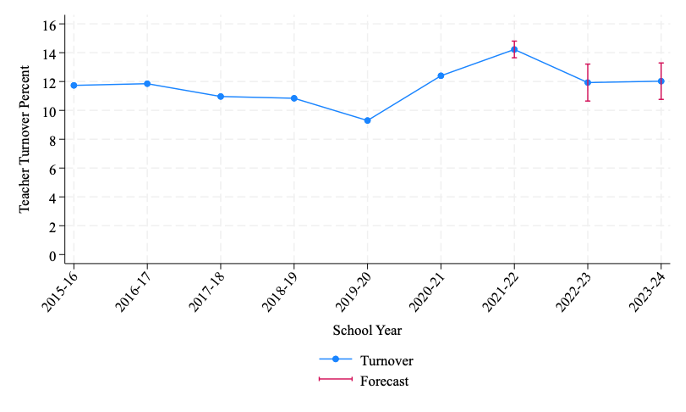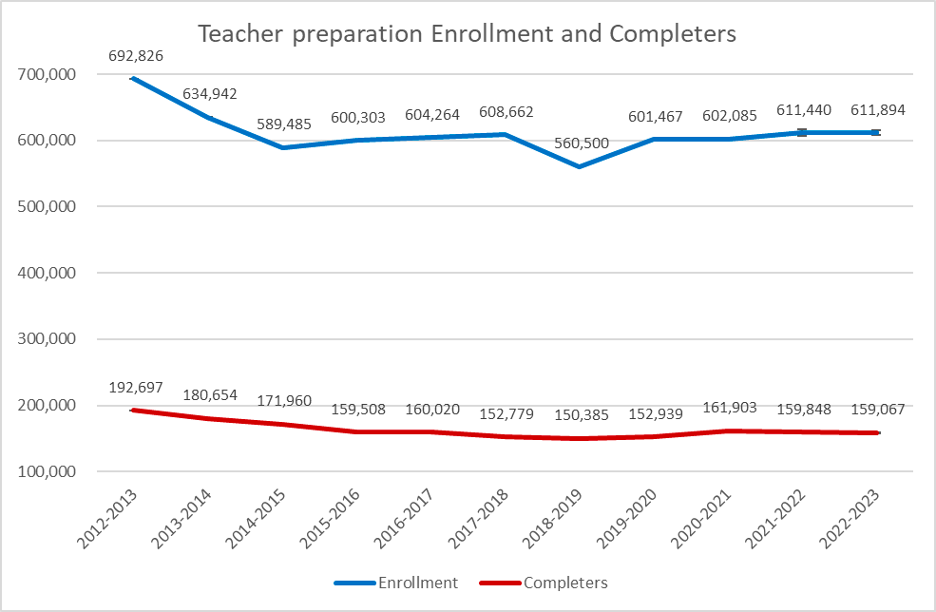
Teachers are critical for student learning. Recent news and policy reports suggest there are shortages of teachers in many parts of the country, and these shortages are detrimental for students and public education since these positions are either left unfilled or are filled with less qualified or uncertified candidates. In order to rigorously examine these issues, first we focus on vacant positions in a state: teaching positions that are left unfilled, even with emergency certification. We take this conservative approach to provide a lower bound on what teacher shortages look like in the United States. Next, we also consider teaching positions that are filled by teachers who are certified by irregular, provisional, temporary, or emergency certification, and teaching positions that are filled by teachers who are certified, but who are teaching in academic subject areas other than their area of preparation. In this updated version, to provide a more comprehensive picture of the factors contributing to teacher vacancy and underqualification, we have further included the current number of students in the state, the numbers of teachers who are enrolled in or completed teacher preparation programs, and the percent of teachers who are leaving the profession. Additionally, we estimate recent levels of teacher turnover and production using a forecast. Collectively, these data provide a comprehensive picture of the factors contributing to the teacher labor market.
Based on data from the last few years, most states have more vacant positions and/or more underqualified teachers in the classroom than in previous years. For the 2024-25 school year, we estimate there are at least 49,000 vacant positions and 400,000 underqualified positions. At the same time, we are seeing a decline or stagnation in enrollment for teacher certification programs for most states as well as a sharp increase in teachers leaving the profession in the last two years compared to the last decade.
Our results clearly indicate the majority of states are experiencing some degree of teacher shortages and teacher turnover surged during the pandemic with more teachers leaving the profession than ever before, though we expect teacher turnover will decrease over the next few years. We hope this work can be used to inform policymakers and researchers about the extent to which states are experiencing teacher shortages and what we can do to address this challenge for the future of public education.
Despite the many reports of teacher shortages, there has not been a concerted effort to examine teacher shortages and turnover nationally. To address this issue, we have systematically examined news reports, department of education websites and presentations, and documented sources of teacher shortages for every state in the United States since 2021. Additionally, we have also contacted state departments for their vacancy/shortage numbers when they are not available online or in print. The map above shows the extent to which there is a teacher vacancy in every state and the most recent date for which we have information, as well as the main source of our information for each state. Based on news and state reports, we estimate that there are at least 49,000 vacant teacher positions in the United States. This is likely an underestimate as some reports are out of date, and some states do not have any information on teacher vacancy. Regarding underqualified teachers, while we were able to retrieve most data from these state-specific data sources, we also leveraged recent reviews of state reports by the Learning Policy Institute and data from the Civil Rights Data Collection (CRDC). To contextually analyze teacher vacancy and underqualification, we retrieved state-level student and teacher populations from the Common Core of Data (CCD). Lastly, data on teacher preparation enrollment and completion come from the US Department of Education under the Title II report, and data on teacher turnover are derived from policy briefs, journal publications, and state licensed personnel data.
We note that the raw vacancy counts do not account for the number of students in a state, thus the interpretation of teacher vacancy is somewhat out of context. We therefore examine teacher vacancy relative to student population. Additionally, as teacher shortages are also indicated by the number of teachers hired by a state without being fully certified, we run a similar analysis on the number of underqualified hires of each state, also relative to their respective student population. We provide links to the relative teacher vacancy and relative teacher underqualification below.
We have also conducted a forecast of teacher turnover using data from 34 states. We use the most recent data available to forecast future trends in teacher turnover. Teacher turnover rose to a historically high 14 percent in the 2021-22 school year. Using data on turnover, Gross Domestic Product, and unemployment rates we predict that teacher turnover will decline to about 12 percent in the 2022-23 school year and will remain stable in the 2023-24 school year. It is important to emphasize that although the 2023-24 school year will soon begin, we do not have data on teacher turnover in the 2022-23 school year or the 2023-24 school year. Teacher turnover may either increase or decrease based on unexpected changes to the economy or education funding (i.e., ESSER fiscal cliff).

We also conducted a forecast on teacher preparation enrollment and completion for all 50 states, using the recent trends reported by Title II data. The number of students enrolled in and those completing teacher preparation programs has plummeted over the last decade, and although there was a slight recovery post-pandemic, our estimates indicate that it stagnates over the 2022-2023 school year.

We acknowledge there are difficulties in measuring teacher shortages/turnover on a state-by-state basis using news reports and state reports as they are often provided without specific definitions of vacancy, whether they include or exclude uncertified teachers, or whether they are only for core academic subjects or all subjects. We will continue to work on collecting various measures of teacher vacancy and shortages, and we will aim to provide multiple measures of vacancy and shortages in the future. Furthermore, we note there are also important variations within and between districts within states that need to be explored and addressed, but the first step is to assess nationally at the state level.
If you have any questions, please contact Tuan D. Nguyen, Ph.D., University of Missouri, via email: tuan.nguyen@missouri.edu or twitter: edu_tuan. Josh Bleiber is available at email: jbleiber@pitt.edu or twitter: JoshBleiberg.
If you have updated data from any state or states without current data or if there are any errors with the data, please email Dr. Tuan Nguyen and share your information, including state's presentations and reports.
This work is derived from a research project by Tuan D. Nguyen, Chanh B. Lam, and Paul Bruno, and a research project by Tuan D. Nguyen, Josh Bleiberg, Patricia Saenz-Armstrong, and Chanh B. Lam.
For our past iterations/publications, please see:
We thank Kate Nelson, Susan Patrick, Allison Gilmour, and Chris Redding for their helpful comments and suggestions. Any errors remain our sole responsibility.

This work is licensed under a Creative Commons Attribution-NonCommercial 4.0 International License.